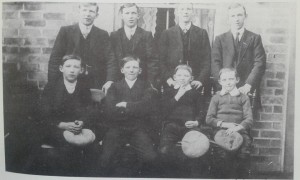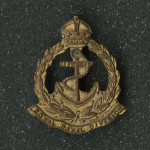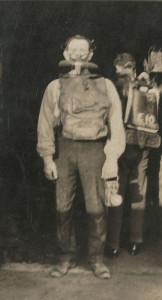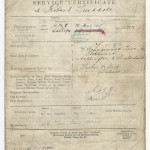Robert Tweddell was born 7 January 1892 to Robert Tweddle and Isabella Scott in Radcliffe, Northumberland, the fifth of eleven children. The family lived in Radcliffe for some years, but by the 1911 census, they are listed as living at Cement Row, Widdrington. This census shows that Robert was a coal miner (Hewer), and the eldest child still living at home.

He enrolled with the Royal Naval Volunteer Reserve on 10 April 1915, aged 23 years, after having a medical examination at Ashington, and joined ‘Z’ Company on HMS Calliope. He was given the service number 4225. We also know from his service certificate that he worked as a miner for Stobswood Coal Company, and lived at 7 Grangewood Terrace, Stobswood. We can also glean some personal details about Robert: he is described as 5’6”, with a fair complexion, fair hair and blue eyes; his religious denomination was Church of England, and he could swim.
The only documents relating to Robert’s war service that seem to exist are a service record, which was passed through his family, and the enrolment application and report card, which were obtained from the Fleet Air Arm Museum in Somerset.
Rated as an Able Seaman in July 1915, he served with the 1st Reserve Battalion on H.M.S. Victory at Crystal Palace. Robert found the time to return home to Northumberland this year to marry Jane Telfer on 31 July. The marriage took place in St. John the Baptist parish church, Ulgham, and the family story is that Robert was the first man in uniform to marry here, although this cannot be verified.
Robert’s report card only runs from 1917. We know he embarked at Folkestone on 3 January 1917, landing at Calais the same day. Joining Howe Battalion on 26 January, he was transported to the 1st Field Ambulance, Royal Naval Division, for dental caries (or cavities) on 6 April, and did not return to his unit until 5 May.
 Whilst Robert was away from his unit his wife, Jane, gave birth to their first child, a son, on 17th April 1917. He was named Robert after his father and grandfather. [Image of a sweetheart brooch that Robert gave Jane]
Whilst Robert was away from his unit his wife, Jane, gave birth to their first child, a son, on 17th April 1917. He was named Robert after his father and grandfather. [Image of a sweetheart brooch that Robert gave Jane]
The report card then jumps to his service in 1918, starting with his leave to the UK, commencing on 25 January 1918 – this was probably the first time he saw his baby son. Robert re-joined the Howe Battalion on 16 February, but was disciplined two days later, having overstayed his English leave by two days W.O.A.S. (whilst on active service) – he received 14 days of Field Punishment Number 1. This punishment, sometimes known as ‘crucifixion’, would have involved Robert being shackled in irons and secured to a fixed object, perhaps a gun wheel. Officially, men could only be fixed like this for up to 2 hours in 24, and not for more than 3 days in 4, or for more than 21 days in a sentence.
He joined the 7th Entrenching Battalion on 22 February 1918, and was then posted to the Drake Battalion on 14 March. On 21 March, he was admitted to 150 Field Ambulance with tonsillitis, and invalided to England on 27 March. A family story notes that this illness was not tonsillitis; instead he had been gassed in the trenches. Again, we have not been able to prove this.
He was granted his first (and last) good conduct badge on 9 April 1918. His service certificate notes that in January 1919, he was ordered to resume civil employment as a miner, with the Stobswood Coal Company, and was discharged from actual service.
Robert and Jane’s second child, another boy, named James Telfer Tweddell, was born on 25 April 1920.
The last piece of military information we have on Robert comes from his service certificate, which records that, on 1 September 1922, he was eligible to be presented with
the British War Medal and the Victory Medal.
Robert continued working as Miner for the rest of his life, also being a member of the Mines Rescue  Unit. During World War Two, he served in Stobswood Home Guard, helping to train the men in use of grenades and other weaponry. It is also believed that he was a member of the Stobswood Auxiliary Unit, nicknamed “The Death or Glory Boys”. [Image of Robert wearing his life saving apparatus].
Unit. During World War Two, he served in Stobswood Home Guard, helping to train the men in use of grenades and other weaponry. It is also believed that he was a member of the Stobswood Auxiliary Unit, nicknamed “The Death or Glory Boys”. [Image of Robert wearing his life saving apparatus].
Robert died in 1953, at the age of 61 years, of lung cancer. Using the parish records for Ulgham Church [EP 19] I managed to find Robert’s name in a notebook which lists plot numbers in the graveyard [EP 19/67], which corresponds with the plan of the churchyard extension [EP 19/48] – we have been able to stand at the spot where my great-granda is buried, impossible to do before as a gravestone was never erected.
Northumberland Archives staff have been undertaking research into the contribution that some of their own family members made to the First World War. Robert Tweddell was a relative of Sarah Littlefear, Trainee Archivist.

